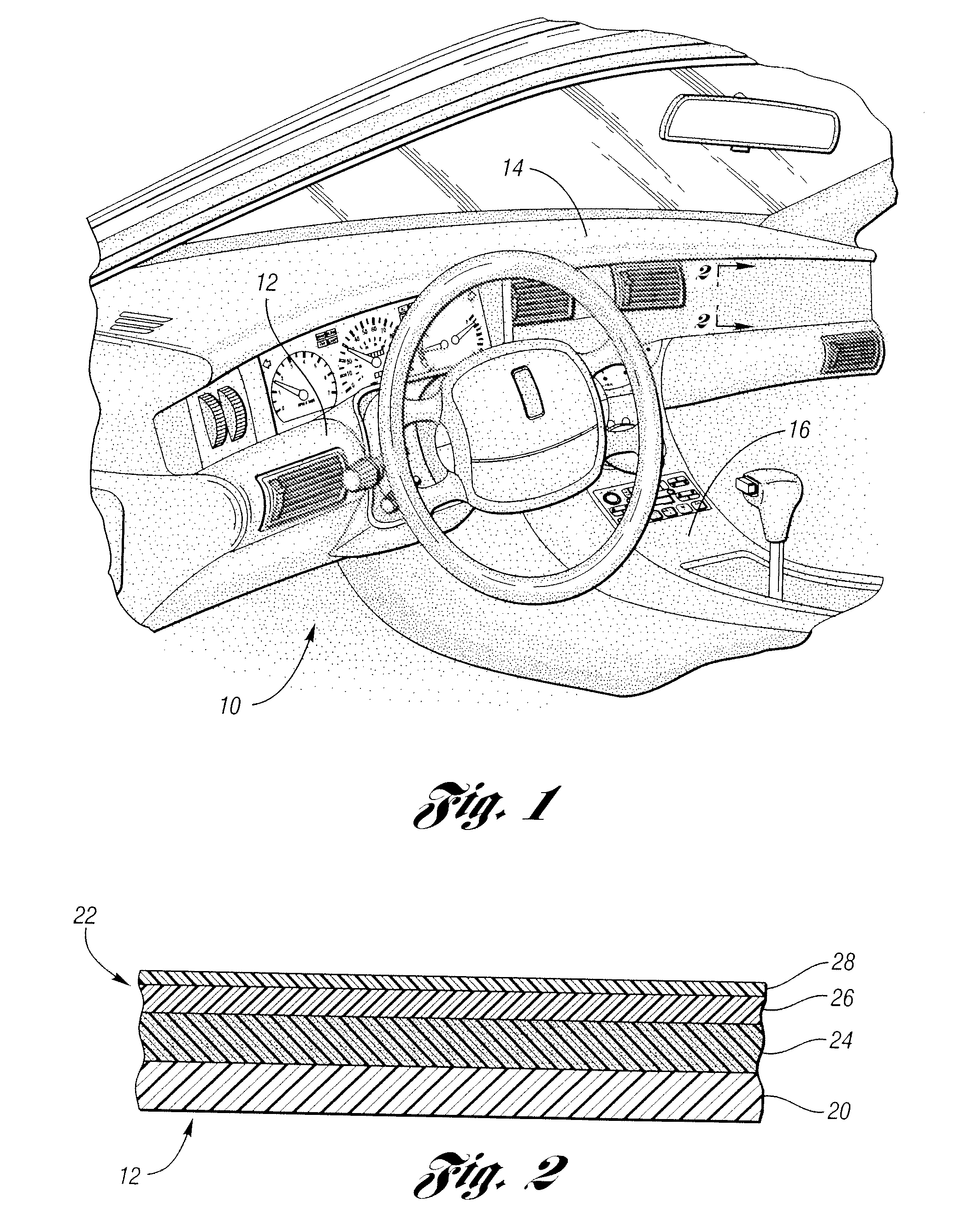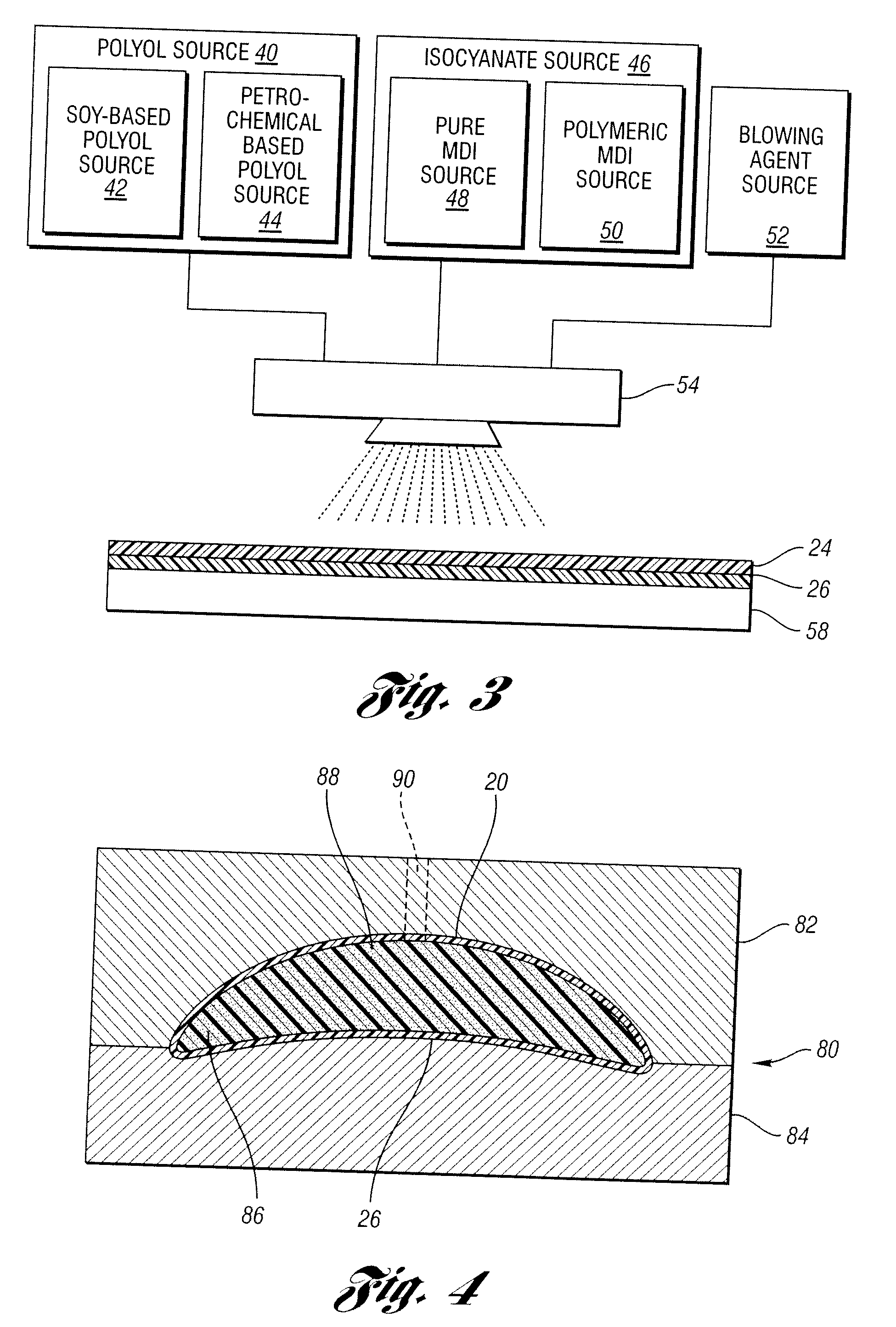Interior panel component for use with a vehicle and method for making
a technology for interior panels and vehicles, applied in the direction of transportation and packaging, other domestic articles, synthetic resin layered products, etc., can solve the problems of long-term economic stability, limited fossil fuel and oil reserves from which they are derived, and soy-based polyurethane foam has not gained acceptance in the automotive industry
- Summary
- Abstract
- Description
- Claims
- Application Information
AI Technical Summary
Benefits of technology
Problems solved by technology
Method used
Image
Examples
example 1
[0045]A series of polyurethane foams using 0-50 pphr of a soy-based polyol are formulated with polymeric MDI. Formulations are given in Tables 1-5. The polyols are a blend of three polyols: soy-based polyol NOP-19A and petrochemical-based polyols 4701, an ethylene oxide capped tri-functional oxy propylene polyether from Dow Chemical (Midland, Mich.), and 4935, a tri-functional styrene acrylonitrile copolymer polyol having about 35% solids and an equivalent weight of 2435, available from Dow Chemical (Midland, Mich.) as their Voranol™ series. Polyol 4935 has a molecular weight range about 4000, and is greater than the molecular weight range of 4701 and NOP-19A. The molecular weight of polyol 4701 exceeds that of polyol NOP-19A.
[0046]Physical properties for the foams of Example 1 are given in Table 6.
[0047]Foams made with polymeric MDI and with between 5% and 20% of the foam's weight (10-40 pphr) of soy-based polyol have advantageous physical properties. Using the same formulation com...
example 2
[0048]A foam with the same components as Example 1 is prepared using 43 pphr of the soy-based polyol as well as 43 pphr of the higher molecular weight petrochemical-based polyol 4935 and 14 pphr of petrochemical-based polyol 4701. The formulation has 25% of the foam weight of soy-based polyol and 25% of the foam weight of petrochemical-based polyol 4935 in the foam. The formulation is available in Table 7. The results for this formulation show that in order to use 25% or more soy-based polyol (43 or more pphr) and achieve advantageous properties, a petrochemical-based polyol, such as polyol 4935 having relatively high number-averaged molecular weight is used. The result is an increase in the elongation to desirable levels when measured using ASTM D412-DIE-C.
example 3
[0049]Forming a composite layer, such as composite 22 of FIG. 2, having a thermoplastic polyurethane skin and a resilient layer of polyurethane foam having 10% by weight of the foam (20 pphr) foam soy-based polyol is tested for physical properties. The formulation is provided in Table 8. The composite layer's physical properties are given in Table 9. Using only polymeric MDI, the compression set, as received, does not have sufficiently advantageous properties.
PUM
| Property | Measurement | Unit |
|---|---|---|
| Fraction | aaaaa | aaaaa |
| Fraction | aaaaa | aaaaa |
| Fraction | aaaaa | aaaaa |
Abstract
Description
Claims
Application Information
 Login to View More
Login to View More - R&D
- Intellectual Property
- Life Sciences
- Materials
- Tech Scout
- Unparalleled Data Quality
- Higher Quality Content
- 60% Fewer Hallucinations
Browse by: Latest US Patents, China's latest patents, Technical Efficacy Thesaurus, Application Domain, Technology Topic, Popular Technical Reports.
© 2025 PatSnap. All rights reserved.Legal|Privacy policy|Modern Slavery Act Transparency Statement|Sitemap|About US| Contact US: help@patsnap.com



